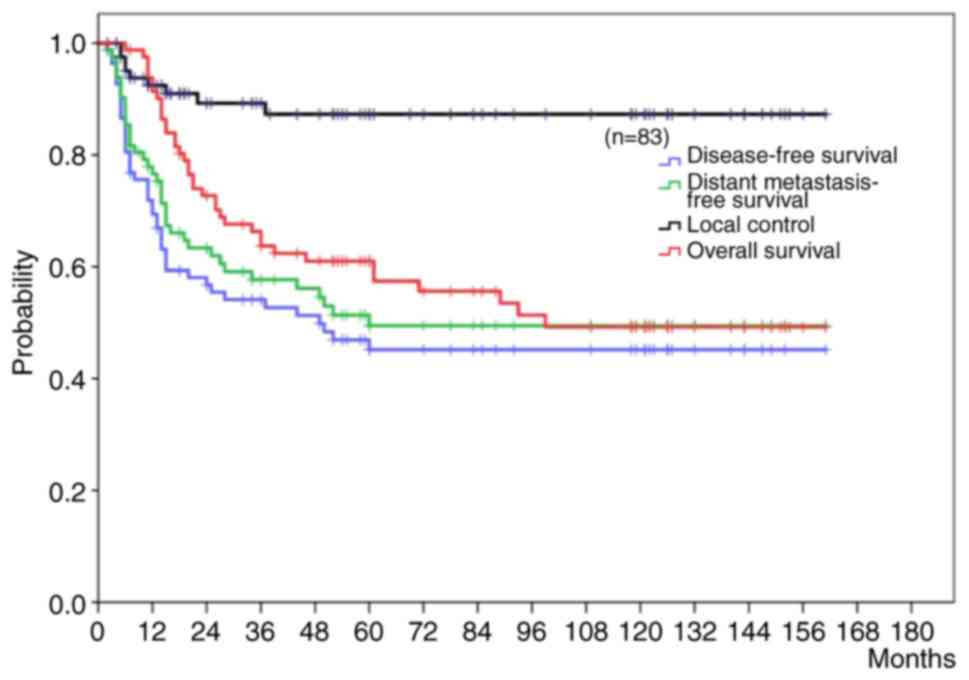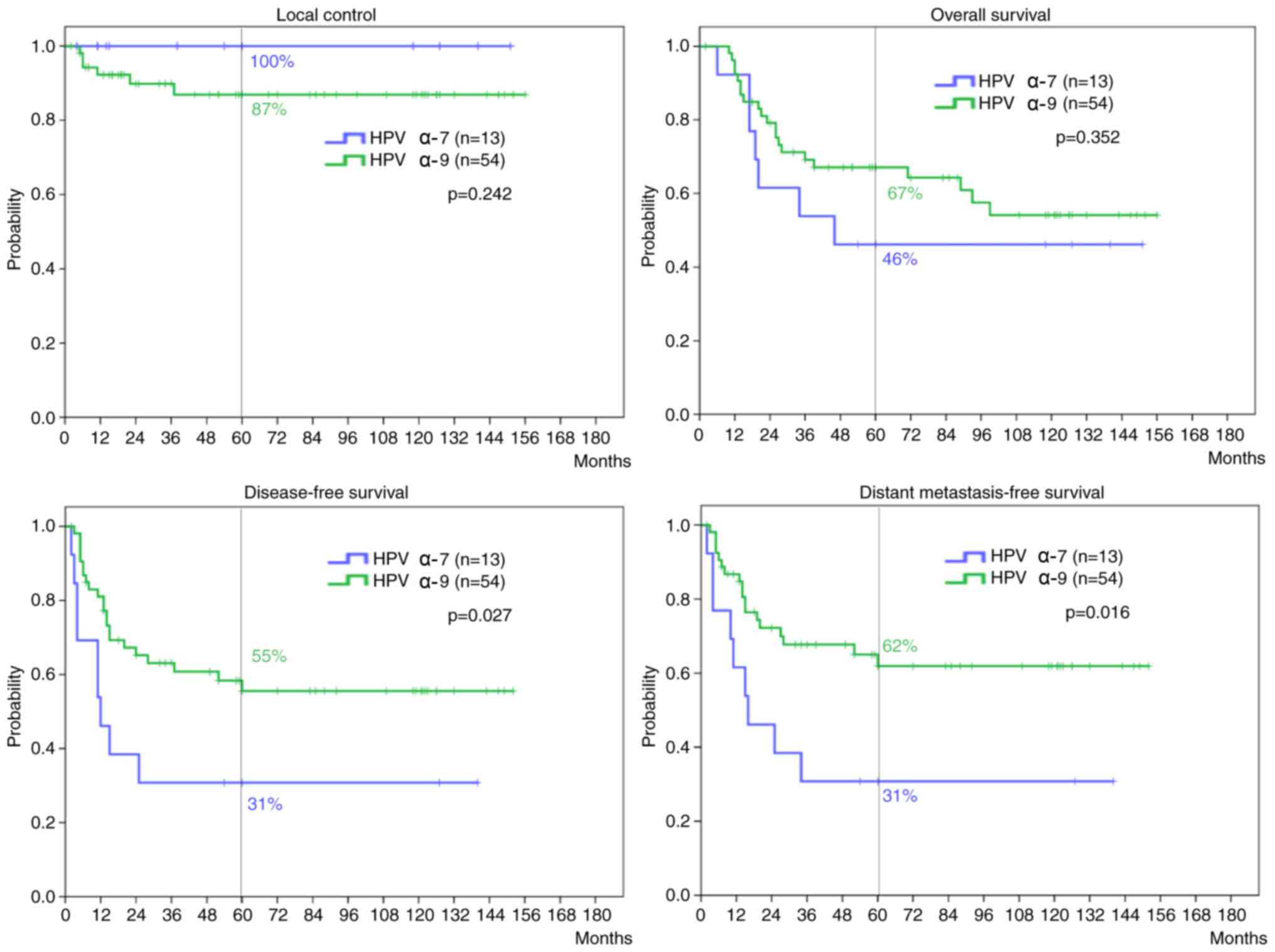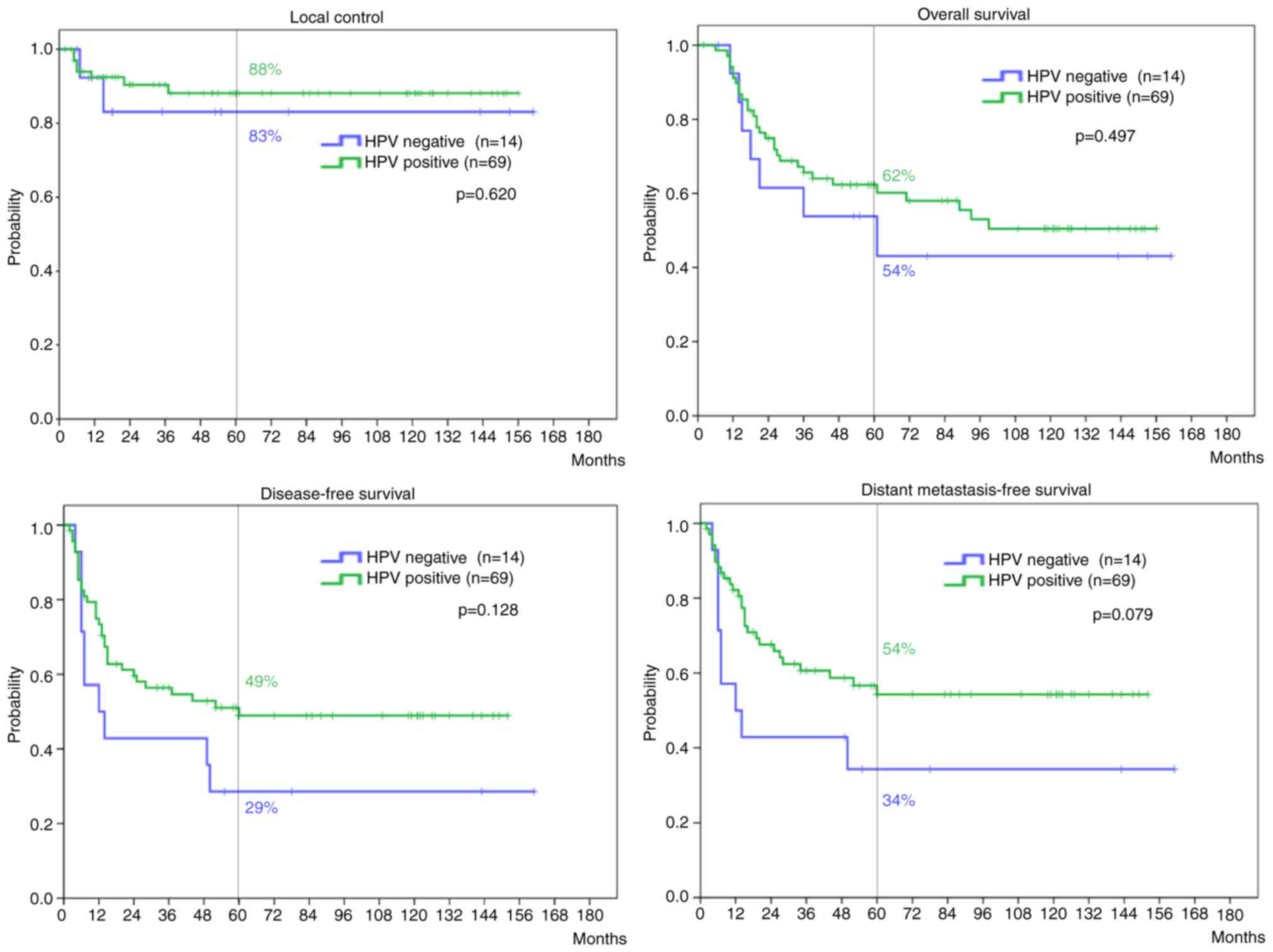|
1
|
Ferlay J, Shin HR, Bray F, Forman D,
Mathers C and Parkin DM: Estimates of worldwide burden of cancer in
2008: GLOBOCAN 2008. Int J Cancer. 127:2893–2917. 2010. View Article : Google Scholar : PubMed/NCBI
|
|
2
|
Cervical cancer: Estimated incidence,
mortality and prevalence worldwide in 2012. International Agency
for Research on Cancer and World Health Organization. 2012,
http://globocan.iarc.fr/Pages/fact_sheets_cancer.aspxDecember
25–2016
|
|
3
|
Bouvard V, Baan R, Straif K, Grosse Y,
Secretan B, El Ghissassi F, Benbrahim-Tallaa L, Guha N, Freeman C,
Galichet L, et al: A review of human carcinogens-Part B: Biological
agents. Lancet Oncol. 10:321–322. 2009. View Article : Google Scholar : PubMed/NCBI
|
|
4
|
Walboomers JM, Jacobs MV, Manos MM, Bosch
FX, Kummer JA, Shah KV, Snijders PJ, Peto J, Meijer CJ and Muñoz N:
Human papillomavirus is a necessary cause of invasive cervical
cancer worldwide. J Pathol. 189:12–19. 1999. View Article : Google Scholar : PubMed/NCBI
|
|
5
|
de Sanjose S, Quint WG, Alemany L, Geraets
DT, Klaustermeier JE, Lloveras B, Tous S, Felix A, Bravo LE, Shin
HR, et al: Human papillomavirus genotype attribution in invasive
cervical cancer: A retrospective cross-sectional worldwide study.
Lancet Oncol. 11:1048–1056. 2010. View Article : Google Scholar : PubMed/NCBI
|
|
6
|
de Villiers EM, Wagner D, Schneider A,
Wesch H, Miklaw H, Wahrendorf J, Papendick U and zur Hausen H:
Human papillomavirus infections in women with and without abnormal
cervical cytology. Lancet. 2:703–706. 1987. View Article : Google Scholar : PubMed/NCBI
|
|
7
|
Parkin DM and Bray F: Chapter 2: The
burden of HPV-related cancers. Vaccine. 3(24 Suppl): S11–S25. 2006.
View Article : Google Scholar
|
|
8
|
American College of Obstetricians and
Gynecologists: ACOG practice bulletin. Diagnosis and treatment of
cervical carcinomas. Number 35, May 2002. American College of
Obstetricians and Gynecologists. Int J Gynaecol Obstet. 78:79–91.
2002.PubMed/NCBI
|
|
9
|
Gaffney DK, Erickson-Wittmann BA, Jhingran
A, Mayr NA, Puthawala AA, Moore D, Rao GG, Small W Jr, Varia MA,
Wolfson AH, et al: ACR Appropriateness Criteria® on
advanced cervical cancer expert panel on radiation
oncology-gynecology. Int J Radiat Oncol Biol Phys. 81:609–614.
2011. View Article : Google Scholar : PubMed/NCBI
|
|
10
|
Monk BJ, Tewari KS and Koh WJ:
Multimodality therapy for locally advanced cervical carcinoma:
State of the art and future directions. J Clin Oncol. 25:2952–2965.
2007. View Article : Google Scholar : PubMed/NCBI
|
|
11
|
Gien LT, Beauchemin MC and Thomas G:
Adenocarcinoma: A unique cervical cancer. Gynecol Oncol.
116:140–146. 2010. View Article : Google Scholar : PubMed/NCBI
|
|
12
|
Lai CH, Chang CJ, Huang HJ, Hsueh S, Chao
A, Yang JE, Lin CT, Huang SL, Hong JH, Chou HH, et al: Role of
human papillomavirus genotype in prognosis of early-stage cervical
cancer undergoing primary surgery. J Clin Oncol. 25:3628–3634.
2007. View Article : Google Scholar : PubMed/NCBI
|
|
13
|
Rose BR, Thompson CH, Simpson JM, Jarrett
CS, Elliott PM, Tattersall MH, Dalrymple C and Cossart YE: Human
papillomavirus deoxyribonucleic acid as a prognostic indicator in
early-stage cervical cancer: A possible role for type 18. Am J
Obstet Gynecol. 173:1461–1468. 1995. View Article : Google Scholar : PubMed/NCBI
|
|
14
|
Burger RA, Monk BJ, Kurosaki T,
Anton-Culver H, Vasilev SA, Berman ML and Wilczynski SP: Human
papillomavirus type 18: Association with poor prognosis in early
stage cervical cancer. J Natl Cancer Inst. 88:1361–1368. 1996.
View Article : Google Scholar : PubMed/NCBI
|
|
15
|
Lombard I, Vincent-Salomon A, Validire P,
Zafrani B, de la Rochefordière A, Clough K, Favre M, Pouillart P
and Sastre-Garau X: Human papillomavirus genotype as a major
determinant of the course of cervical cancer. J Clin Oncol.
16:2613–2619. 1998. View Article : Google Scholar : PubMed/NCBI
|
|
16
|
Huang LW, Chao SL and Hwang JL: Human
papillomavirus-31-related types predict better survival in cervical
carcinoma. Cancer. 100:327–334. 2004. View Article : Google Scholar : PubMed/NCBI
|
|
17
|
Lai HC, Sun CA, Yu MH, Chen HJ, Liu HS and
Chu TY: Favorable clinical outcome of cervical cancers infected
with human papilloma virus type 58 and related types. Int J Cancer.
84:553–557. 1999. View Article : Google Scholar : PubMed/NCBI
|
|
18
|
de Villiers EM, Fauquet C, Broker TR,
Bernard HU and zur Hausen H: Classification of papillomaviruses.
Virology. 324:17–27. 2004. View Article : Google Scholar : PubMed/NCBI
|
|
19
|
Doorbar J: Molecular biology of human
papillomavirus infection and cervical cancer. Clin Sci (Lond).
110:525–541. 2006. View Article : Google Scholar : PubMed/NCBI
|
|
20
|
Wang CC, Lai CH, Huang HJ, Chao A, Chang
CJ, Chang TC, Chou HH and Hong JH: Clinical effect of human
papillomavirus genotypes in patients with cervical cancer
undergoing primary radiotherapy. Int J Radiat Oncol Biol Phys.
78:1111–1120. 2010. View Article : Google Scholar : PubMed/NCBI
|
|
21
|
Hall JS, Iype R, Armenoult LS, Taylor J,
Miller CJ, Davidson S, de Sanjose S, Bosch X, Stern PL and West CM:
Poor prognosis associated with human papillomavirus α7 genotypes in
cervical carcinoma cannot be explained by intrinsic
radiosensitivity. Int J Radiat Oncol Biol Phys. 85:e223–e229. 2013.
View Article : Google Scholar : PubMed/NCBI
|
|
22
|
Ishikawa H, Mitsuhashi N, Sakurai H,
Maebayashi K and Niibe H: The effects of p53 status and human
papillomavirus infection on the clinical outcome of patients with
stage IIIB cervical carcinoma treated with radiation therapy alone.
Cancer. 91:80–89. 2001. View Article : Google Scholar : PubMed/NCBI
|
|
23
|
Woo YL, Damay I, Stanley M, Crawford R and
Sterling J: The use of HPV linear array assay for multiple HPV
typing on archival frozen tissue and DNA specimens. J Virol
Methods. 142:226–230. 2007. View Article : Google Scholar : PubMed/NCBI
|
|
24
|
Nakamura E, Iwakawa M, Furuta R, Ohno T,
Satoh T, Nakawatari M, Ishikawa K, Imadome K, Michikawa Y, Tamaki
T, et al: Villin1, a novel diagnostic marker for cervical
adenocarcinoma. Cancer Biol Ther. 8:1146–1153. 2009. View Article : Google Scholar : PubMed/NCBI
|
|
25
|
Salehi-Vaziri M, Sadeghi F, Hashemi FS,
Haeri H, Bokharaei-Salim F, Monavari SH and Keyvani H: Distribution
of human papillomavirus genotypes in iranian women according to the
severity of the cervical lesion. Iran Red Crescent Med J.
18:e244582016.PubMed/NCBI
|
|
26
|
García Muentes GD, García Rodríguez LK,
Galarraga RI Burgos, Carpio F Almeida and Cabezas JC Ruiz:
Genotypes distribution of human papillomavirus in cervical samples
of Ecuadorian women. Rev Bras Epidemiol. 19:160–166. 2016.
View Article : Google Scholar : PubMed/NCBI
|
|
27
|
Wang L, Wu B, Li J and Chen L: Prevalence
of human papillomavirus and its genotype among 1336 invasive
cervical cancer patients in Hunan province, central south China. J
Med Virol. 87:516–521. 2015. View Article : Google Scholar : PubMed/NCBI
|
|
28
|
Lin QQ, Yu SZ, Qu W, Cruz Y and Burk RD:
Humanpapillomavirus types 52 and 58. Int J Cancer. 75:484–485.
1998. View Article : Google Scholar : PubMed/NCBI
|
|
29
|
Lin H, Ma YY, Moh JS, Ou YC, Shen SY and
ChangChien CC: High prevalence of genital human papillomavirus type
52 and 58 infection in women attending gynecologic practitioners in
South Taiwan. Gynecol Oncol. 101:40–45. 2006. View Article : Google Scholar : PubMed/NCBI
|
|
30
|
Lai CH, Huang HJ, Hsueh S, Chao A, Lin CT,
Huang SL, Chao FY, Qiu JT, Hong JH, Chou HH, et al: Human
papillomavirus genotype in cervical cancer: A population-based
study. Int J Cancer. 120:1999–2006. 2007. View Article : Google Scholar : PubMed/NCBI
|
|
31
|
Kusanagi Y, Kojima A, Mikami Y, Kiyokawa
T, Sudo T, Yamaguchi S and Nishimura R: Absence of high-risk human
papillomavirus (HPV) detection in endocervical adenocarcinoma with
gastric morphology and phenotype. Am J Pathol. 177:2169–2175. 2010.
View Article : Google Scholar : PubMed/NCBI
|
|
32
|
Fyles AW, Pintilie M, Kirkbride P, Levin
W, Manchul LA and Rawlings GA: Prognostic factors in patients with
cervix cancer treated by radiation therapy: Results of a multiple
regression analysis. Radiother Oncol. 35:107–117. 1995. View Article : Google Scholar : PubMed/NCBI
|
|
33
|
Werness BA, Levine AJ and Howley PM:
Association of human papillomavirus types 16 and 18 E6 proteins
with p53. Science. 248:76–79. 1990. View Article : Google Scholar : PubMed/NCBI
|
|
34
|
Villa LL and Schlegel R: Differences in
transformation activity between HPV-18 and HPV-16 map to the viral
LCR-E6-E7 region. Virology. 181:374–377. 1991. View Article : Google Scholar : PubMed/NCBI
|
|
35
|
Arends MJ, Wyllie AH and Bird CC: Human
papillomavirus type 18 is associated with less apoptosis in
fibroblast tumours than human papillomavirus type 16. Br J Cancer.
72:646–649. 1995. View Article : Google Scholar : PubMed/NCBI
|
|
36
|
Hampson L, El Hady ES, Moore JV, Kitchener
H and Hampson IN: The HPV16 E6 and E7 proteins and the radiation
resistance of cervical carcinoma. FASEB J. 15:1445–1447.
2001.PubMed/NCBI
|
|
37
|
Harris BZ and Lim WA: Mechanism and role
of PDZ domains in signaling complex assembly. J Cell Sci.
114:3219–3231. 2001.PubMed/NCBI
|
|
38
|
Izumchenko E, Singh MK, Plotnikova OV,
Tikhmyanova N, Little JL, Serebriiskii IG, Seo S, Kurokawa M,
Egleston BL, Klein-Szanto A, et al: NEDD9 promotes oncogenic
signaling in mammary tumor development. Cancer Res. 69:7198–7206.
2009. View Article : Google Scholar : PubMed/NCBI
|
|
39
|
Kim M, Gans JD, Nogueira C, Wang A, Paik
JH, Feng B, Brennan C, Hahn WC, Cordon-Cardo C, Wagner SN, et al:
Comparative oncogenomics identifies NEDD9 as a melanoma metastasis
gene. Cell. 125:1269–1281. 2006. View Article : Google Scholar : PubMed/NCBI
|
|
40
|
Kondo S, Iwata S, Yamada T, Inoue Y,
Ichihara H, Kichikawa Y, Katayose T, Souta-Kuribara A, Yamazaki H,
Hosono O, et al: Impact of the integrin signaling adaptor protein
NEDD9 on prognosis and metastatic behavior of human lung cancer.
Clin Cancer Res. 18:6326–6338. 2012. View Article : Google Scholar : PubMed/NCBI
|












